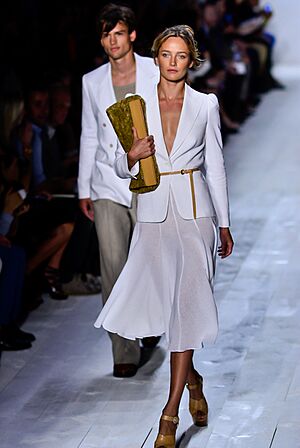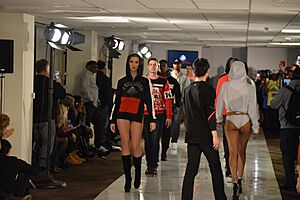Fashion week facts for kids
A fashion week is a super exciting event in the world of fashion! It's usually a week long, and during this time, fashion designers and big fashion brands show off their newest clothing collections. They do this through amazing fashion shows on a runway.
These shows are really important because they help buyers (people who buy clothes for stores) and the media (like fashion magazines and websites) see what's new. This helps set the fashion trends for the upcoming seasons.
The most famous fashion weeks happen in the world's biggest fashion cities. These are New York City, London, Milan, and Paris. People often call these the "Big Four." When these four fashion weeks happen one after another, it's known as "fashion month."
Fashion weeks first started in Paris in the late 1800s. Later, they spread to New York, Milan, and London in the 1900s. What began as a simple way to show off clothes in public places, like racetracks, grew into huge, well-known events. In the 2000s, people started talking more about making fashion sustainable, which means being kinder to the planet. This idea became very popular over the next ten years.
Recently, fashion weeks have changed to fit a faster way of shopping. Now, some shows let you "see now, buy now," meaning you can buy the clothes right after or even during the show! Event organizers have also suggested combining shows for different seasons or for men's and women's clothes. This helps reduce the pollution caused by all the travel and events.
Contents
The History of Fashion Week
One of the first ideas for a fashion week or a seasonal collection came from a designer named Charles Frederick Worth in the late 1800s. The whole idea of fashion week began in Paris, France. Back then, marketers would hire women to wear fancy couture clothes in public places. This included places like racetracks and beauty salons. These "fashion parades" slowly became social events on their own. In France, fashion shows are still called "défilés de mode," which means "fashion shows" or "fashion parades."
A fashion show is an event put on by a fashion designer. They use it to show their new line of clothes and accessories during Fashion Week. These shows happen every season, especially for Spring/Summer and Fall/Winter collections.
How Paris Fashion Week Began
The first Paris Fashion Week was largely thanks to designer Paul Poiret. He was known as the "King of Fashion" in the early 1900s. Poiret wanted to show his designs on real people who were moving around. To make this happen, he decided to mix social gatherings with shopping. He threw many fancy parties where his designs were featured. Guests were asked to wear their best clothes to match his beautiful designs.
As these shows continued, they became smaller and more private. Fashion houses started dressing models in their collections for only a few special guests. Unlike today's fashion shows, photographers were not allowed. This was because designers worried about their ideas being copied.
The official Paris Fashion Week started in 1973. This happened when the Fédération Française de la Couture was formed. The first big event was the famous Battle of Versailles Fashion Show. This show featured a competition between five top French designers and five American designers. The American designers were not as well-known at the time.
Early Fashion Shows in America
In 1903, a store in Manhattan called Ehrich Brothers held what many believe was the first fashion show in the United States. They did this to attract middle-class women to their store. By 1910, many large department stores were holding their own shows. It's likely that American stores saw the "fashion parades" in Paris and decided to try the idea. These "parades" were great for promoting stores and making them seem more important.
By the 1920s, fashion shows were used by stores all over the country. They were often held in the store's restaurant during lunch or tea time. These shows were usually more like a play than today's shows. They often had a strong theme and a story told by a narrator.
The Start of New York Fashion Week
On July 19, 1943, the very first "fashion week" was held in New York. This was New York Fashion Week. It was created to give fashion buyers other options besides French fashion during World War II. At that time, people in the fashion industry couldn't easily travel to Paris.
Fashion shows became incredibly popular, attracting thousands of people. The crowds were so big that in the 1950s, stores in New York needed a special license to have live models. Until 1994, shows were held in many different places, like hotels or lofts. From 1994 to 2009, the event took place in a tent at Bryant Park. This park is behind the New York Public Library.
From 2010 to 2015, Lincoln Center was the main place for Fashion Week. After that, it moved to Clarkson Square in SoHo, Manhattan. After 2017, New York Fashion Week started using many different locations instead of just one main spot.
Fashion and a Greener Planet
Before big fashion events like fashion week started focusing on sustainability, some brands were already doing it. For example, Patagonia made clothes from recycled materials. In 2009, the Copenhagen Fashion Summit was created to talk about environmental issues in the fashion world. Designers were asked to make fewer collections each year. Instead, they were encouraged to create clothes that lasted longer, which helps reduce waste. Shoppers were also encouraged to buy fewer, but better quality, items that would last. These ideas help create a circular economy, where things are reused and recycled.
In 2014, a group called Connect4Climate (part of the World Bank Group) helped fund an event at Milan Fashion Week. This event aimed to support new, young designers who focused on sustainability. At London Fashion Week in 2017, designer Vivienne Westwood and the Mayor of London started the "Fashion Switch" project. This helped UK fashion brands switch to using renewable energy. In Asia, Lakme Fashion Week in 2018 promoted "mindful fashion" and designers who focused on being eco-friendly. Connect4Climate also launched "X-Ray Fashion," a virtual reality experience that showed how climate change and fashion are connected. The next year, big brands like H&M, Burberry, and Zara started using materials that were sourced in a sustainable way.
In 2019, important agreements like the "Fashion Pact" and "Fashion Industry Charter for Climate Action" set goals for the fashion industry. These goals included using green energy, better material use, and modernizing how clothes are made to reduce carbon pollution. At London Fashion Week, the British Fashion Council promoted upcycling (making new things from old items) and remanufacturing (making new products from used ones). They did this by showing new sustainable brands in designer showrooms. Famous brands like Chanel and Dolce & Gabbana also showed sustainable designs in their Spring and Summer 2020 collections.
That same year, designer Gabriella Hearst organized New York Fashion Week’s first carbon neutral fashion show. This meant she made sure the show didn't add any carbon to the atmosphere. She did this by balancing out emissions, booking models who were already in the area, and hiring caterers who used local food. In May 2020, designer Richard Malone won a big award for his new ideas in sustainable fashion. Lakme Fashion Week also started the Circular Design Challenge, which was the first award for sustainable fashion in India.
Since 2021, groups that care about the environment have been at London Fashion Week and other big shows. They have even protested to ask for better environmental and worker protections in the fashion industry. For example, organizers of Copenhagen Fashion Week in 2023 set 18 rules for brands taking part. This was a big step! For instance, all seat cards and set pieces had to be recyclable, fur was banned, and designs had to be made of 50% recycled material. These rules are helping fashion weeks become more sustainable.
The Big Four Fashion Weeks
While there are many important fashion weeks around the world, only four are known as the "Big Four." These are New York, London, Milan, and Paris.
Paris started holding its fancy couture shows in 1945. Milan Fashion Week was founded by the Italian Chamber of Commerce in 1958. Paris Fashion Week became more organized in 1973 under the French Fashion Federation. And London Fashion Week was started by the British Fashion Council in 1984. Even though these main groups organize the biggest shows, there are also many independent events and designers in all these cities. Other notable fashion weeks are held in places like Copenhagen, Berlin, Madrid, São Paulo, Shanghai, and Tokyo.
When Fashion Weeks Happen
The "Big Four" fashion weeks happen twice a year in the major fashion cities. These are New York, London, Milan, and Paris.
Traditionally, fashion weeks were held several months before the actual season. This gave fashion journalists and buyers a chance to see the new designs for the next season. For example, in February and March, designers would show their autumn and winter collections. Then, in September and October, they would show their spring and summer collections.
This timing was set up to match the slower "retail cycle" of the past. It gave stores enough time to buy the designs and plan their marketing. However, people now expect to get new clothes much faster. Because of this, the retail cycle has sped up. So, in 2016, designers started moving to "in-season shows."
See Now, Buy Now Fashion
In recent years, some fashion shows have started featuring clothes that you can buy right away. You can often buy them online or in stores. This is called "see now, buy now" fashion. Sometimes, these shows even have clickable videos where you can buy the looks during or right after the show!
Designers like Tom Ford, Nicole Miller, Moschino, and Tommy Hilfiger have used "see now, buy now" shows. In 2019, Tommy Hilfiger talked about how innovative this idea was during his Tommy x Zendaya show. However, the French Federation of Fashion had not fully adopted this idea as of 2017. The "see now, buy now" trend also came about because of "fast fashion" stores. These stores quickly copy designs from the runway and sell them much faster than traditional fashion houses.
The Environmental Impact of Fashion Weeks
Fashion weeks, especially the "Big Four" and other big trade shows, create a lot of carbon dioxide (CO2) pollution. About 241,000 tons of CO2 are released each year from people attending these events. Buyers and sellers create emissions and waste from flying, staying in hotels, driving, and the fashion shows themselves. New York Fashion Week alone accounts for 37% of the total CO2 emissions from these events.
The average person's carbon footprint is much smaller than a professional buyer's. Buyers often travel about 19,213 kilometers (about 11,938 miles) every year. When they fly in business class, they can create up to 30% more CO2 emissions per person compared to flying in economy. It's hard for event organizers to ask guests to fly economy or share rooms. However, things like paper invitations and plastic water bottles at events are now mostly gone.
Organizers for fashion week and other big events have also suggested combining all the collections for one season. They also propose showing men's and women's clothes at the same event. Another idea is to create fashion "districts" in cities like New York to reduce traffic congestion during fashion week. Making fashion week more sustainable helps the whole fashion industry become more eco-friendly. This is because fashion week shows what's popular and what people want to buy.
More to Explore
- List of fashion events
- Fashion show
- Fashion
- Haute couture
- Ready-to-wear
See also
 In Spanish: Semana de la Moda para niños
In Spanish: Semana de la Moda para niños



